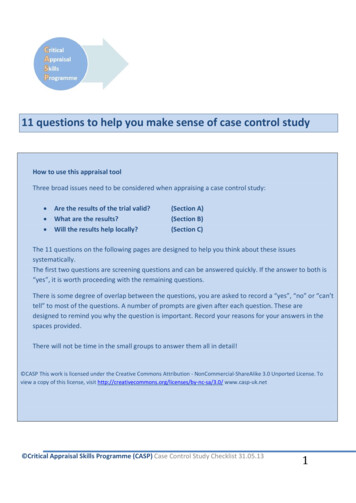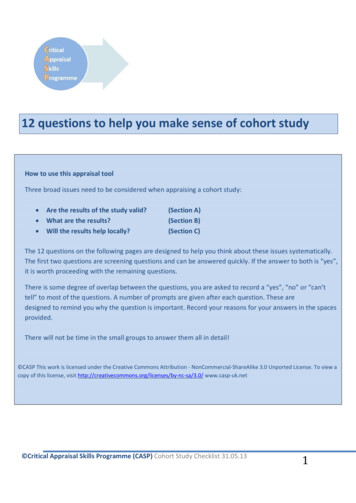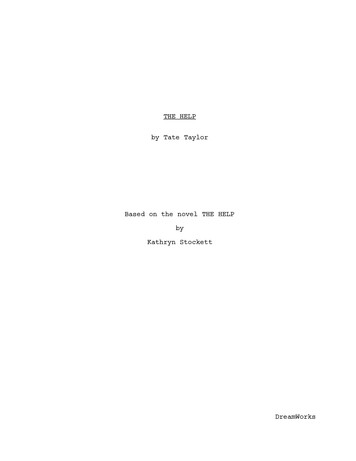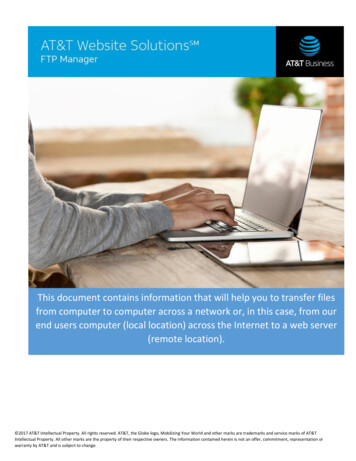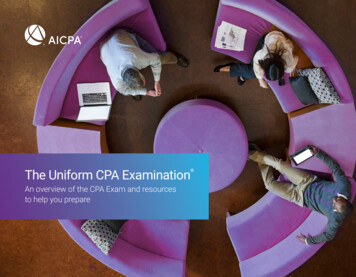
Transcription
PRACTICE QUESTIONSTO HELP YOU MASTER THE PART II FRM EXAMWiley 2016
FRM Exam Reviewefficientlearning.com/frmTop questions you must master to pass the Part II FRM ExamPreparing for the Part II exam is tough, but you can make life easier with an effective studyplan. If you have yet to get a plan, Wiley’s adaptive Digital Exam Planner in our Silver andSelf-Study FRM review courses will help you create a personalized plan down to the day,provide a dashboard to keep on track and track your progress every step of the way.But first, here are some questions to test your knowledge of typical, fundamental topics thatare likely to appear on the actual exam.1. You are leading a discussion with bank interns on thefinancial crisis. You go over the issues associated withliquidity and repo failure in a crisis of confidence. Oneintern asks if the crisis was driven by bank failure or bankinsolvency. What is the difference between the two?A. Insolvency is a bank’s inability to pay its employeesand is forced into receivership, whereas a bank failureis an event where depositors lose a significant amountof cash on hand.B. Insolvency is when a central bank or lender of lastresort steps in to bail out an institution. A bank failureis the event where there is no lender of last resort.C. Bank insolvency is just like any insolvency whenliabilities exceed assets. A bank failure is the collapseof the bank with significant loss to depositors andcreditors.D. Insolvency is the event that triggers SecuritiesInvestor Protection Corporation (SIPC) protectionof depositor balances, and a failure is when thatdepositor insurance is insufficient to cover alldepositors.Answer: CBank failure is extremely rare in the modern world. This isa Lehman-type event: It could be argued that Lehman wasinsolvent long before failure but continued to do businessbecause it could continue to raise capital in the repo orshort-term funding markets. Insolvency is just like anyother insolvency; a failure is when a bank collapses and noteven a central bank can bail them out.2. A junior analyst is reviewing credit decision rules and youwant to spot-check their understanding of the relativeimpacts of bad credit decisions. You describe a scenariowhere there are only two states of the world, good firmsand bad firms, and the firm is classified either correctlyor not, leading to four potential states of the world. Whattype of decision rule does this describe?A. Minimax decision ruleB. Neyman-Pearson ruleC. Baysian decision treeD. Reject-rate ruleAnswer: BThe Neyman-Pearson focuses on the impact of type I andtype II errors and that means a good company classifiedeither correctly or not and vice versa for bad companies. Inthis case, a type I error is damaging to the bank because aloan is actually extended to a defaulting bad firm, whereasa type II error would mean that credit was not extendedto a nondefaulting bad firm (missed opportunity but not acredit loss).The other choices are all real decision types we will get tolater in the notes and other practice questions.3. During a review of the credit book, you want to do a spotcheck of the loss given default (LGD) assumptions andcalculations associated with credit default swaps. Of thefollowing, which is the correct definition of LGD?A. Loss given default is the difference between recoveryand exposure.B. The LGD is known in advance because it is a function ofexposure to the defaulting party but the probability ofdefault is not known with certainty.C. LGD is the probability of default divided by theexpected loss.D. LGD is the exposure minus recovery.Answer: DThere are lots of ways to express LGD and only the lastanswer choice does it correctly. The first choice is wrongbecause it is reversed: LGD is the difference betweenexposure and recovery, not the other way around. For thesecond answer choice, LGD is not known with certaintybeforehand. There is a lot of research that guides what canbe expected to be recovered from different credit ratingsthat default but we can’t know with certainty. The thirdanswer choice is wrong because it is flipped: LGD is theexpected loss divided by the probability of default, leavingthe last answer as the only correct choice.Wiley 2016
FRM Exam Review4. In a meeting with a client for an ISDA negotiation, youask how the client calculates credit VaR. The client repliesthat they approximate credit VaR by making assumptionsabout the variance of expected losses.Which of the following statements is correct with respectto credit VaR and its relationship to expected losses?A. Credit value at risk is expected losses plus unexpectedlosses.B. Expected losses will always be greater than creditVaR.C. Unexpected losses are the difference between a bond’spar value and its expected future value.D. Credit VaR is the worst-case loss over some thresholdminus the expected losses.Answer: DAlways think of value at risk in terms of being over somethreshold. Also know that expected losses are thosethat can be reasonably expected and unexpected lossesare those that occur after that. The third answer choicereverses this relationship. The first choice reverses thecorrect answer, and credit VaR will always be much greaterthan expected losses.5. Dispersions of returns is a key driver of return divergenceacross multiple accounts managed by the same managerand, in theory, all managed in the same way. Which ofthe following statements best describes the relationshipbetween the causes of divergence and portfolio returns?A. If the estimated alphas, risk factors, and transactioncosts stay constant over time, then any dispersion ofreturns will converge over time as cash flows come inand out of the fund.B. Dispersion of returns can be caused by separateaccounts whose betas and risk factor exposuresdiverge over time simply due to the inattention of thefund manager.C. As the alphas and risks across different accounts varyover time, dispersion will increase.D. Dispersion can be minimized if a portfolio managerrebalances existing portfolios and adds new cash tomatch the rebalanced fund, managing old and newcash along the same risk factors and betas.Answer: BYou may be confused about why the last choice is notthe answer because it seems to make perfect sense. Thetheory behind why new cash and old cash should notbe identical is the old cash was built on old informationwithin the constraints of either the customer or transactioncosts and is currently optimal given those constraints.Adding new cash to a currently optimal portfolio gives upreturn in favor of what the manager has now as opposedto what they think is best. A technical argument, yes,efficientlearning.com/frmbut one you need to understand, because that is the keydriver of confusion about where dispersion comes from.Different investors, investing at different times, managedby the same manager along the same risk factors will havedivergence of returns because the risks may be the samebut the optimal asset to express that risk may be different.The third answer is also counterintuitive. It seems that ifthe risk factors and alphas vary over time dispersion willincrease, but think of the concept of dollar-cost averagingin a mutual fund where you invest 100 a month over anumber of years. If each investment were frozen in whatsecurities the manager had at that time (not the net assetvalue, the actual bucket of securities), then the dispersionof one month to the next would never be resolved (asthe manager updates with new information and changesallocation but keeps risk and risk factors the same).However, over time, as factors and allocation change, thedivergence among all those individual contributions will bereduced.6. VaR has moved beyond a simple risk management toolto include aspects of improving the capital allocationprocess. Which of the following statements correctlyidentifies the way VaR can be used in the investmentprocess?A. VaR can identify the relative risk among asset classesand a portfolio manager could choose the assetallocation with the lowest VaR and highest expectedreturn.B. VaR can be used to refine the strategic asset allocationdecision by looking at the top-level risk of a portfolioand compare that risk-return profile to any othercombination the manager might suggest.C. VaR on a standalone basis can be misleading, butincremental VaR in a portfolio context can point out aportfolio that is already optimal.D. The best use of a portfolio VaR used in the investmentprocess is one that focuses on each portfolioindividually and sums up the individual VaRs acrossasset classes.Answer: CThe issue here is that VaR in the asset allocation processis really about the incremental VaR of a portfolio. Thestandalone VaR may be a big number but when looking atchanges to that asset allocation, the marginal VaR couldbe very small. That means that for large changes to theportfolio, the risk change is small, so it is not an optimalmodification to the portfolio even though the standalonerisk of that position may have been quite high. In thissection we always want to think about the portfolio contextof VaR and especially marginal VaR.7. There are many tools used to quantify a risk-adjustedreturn on a portfolio. Which of the following is paired withits correct description?Wiley 2016
FRM Exam ReviewA. Treynor’s measure: The excess return per unit of risk,where risk is defined as the standard deviation ofreturns.B. Sharpe’s measure: The excess return per unit of risk,where risk is defined as the standard deviation ofreturns.C. Jensen’s measure: The measure of return that isexpected from the CAPM.D. Information ratio: The alpha of a portfolio divided bythe systematic risk of that portfolio.Answer: BThe first choice would be correct if we defined risk as thebeta of the portfolio. For the third choice, Jensen is what isexpected above and beyond the CAPM, and the last choiceis incorrect because we divided the alpha of the portfolioby the nonsystematic risk instead of tracking error.8. Which of the following is not a reason that hedge fundsare sometimes difficult to measure against the relativeperformance to other asset classes?A. A hedge fund’s risk factors may change quickly andnot lend themselves to standard risk measures such asVaR.B. Hedge funds may invest in illiquid assets that aredifficult to measure on a mark-to-market basis. Thelack of price granularity can also underestimatevolatility.C. Survivorship bias among hedge funds is a majorconcern; since the failure of funds is so high, the worstperformers drop out of third-party data sets.D. Many hedge funds pursue very-short-term gains, butover long periods of time, the risk-adjusted return is inline with other broad asset classes.Answer: DIn the last choice, the answer is reversed. Hedge fundssometimes pursue strategies that may take a long timehorizon to be profitable but are unable to stay solventwhile those strategies are realized. All other answer choicesare correct.9. The question of moral hazard often is discussed withrespect to a liquidity crisis or runs on a bank. In thiscase, providers of short-term liquidity, who are very riskaverse, pull funding from a bank. Should the market relyon a lender of last resort (LOLR) in crises, how does thatcreate moral hazard?A. If an LOLR takes collateral for loans provided to theborrower, the LOLR faces the risk that those creditassets could default and damage the LOLR.B. The presence of an LOLR may change an institution’sviews on risk and ignore liquidity or funding risks intheir risk planning.efficientlearning.com/frmC. The LOLR increases the cost of funding a bank’sbalance sheet because providers of that capital willdemand more credit spreads if an LOLR also has to bepaid.D. Moral hazard is created when the banks continue tolend and create capital knowing the LOLR could likelybail out the providers of short-term liquidity that areunable to fulfill their obligations.Answer: BIn all cases, moral hazard is when bad behavior doesn’tmatch potential bad consequences. In this case, if youknow the Fed or some other institution will bail you out ina liquidity crisis, then that reduces the capital you have toallocate against the potential outcome. The answer “If anLOLR takes collateral for loans provided to the borrower,the LOLR faces the risk those credit assets could defaultand damage the LOLR” is sneakily close. It is true that theLOLR could be forced to take on additional assets andthose assets could potentially default, but that is onepotential policy response an LOLR could make in responseto moral hazard created by an investment bank that mightexpect a bailout.10. One of the challenges faced within the modern financialbanking system is distinguishing between a bankexperiencing stress because of solvency issues and abank experiencing a macro shock. Despite what mightseem an obvious difference, in the early stages of a crisisthey are difficult to differentiate. How can a policy mix ofliquidity regulation and LOLR lending be an optimal wayto manage systemic risks?A. The conflict between keeping liquidity balancesin a “lockbox” that can’t be touched (liquidityrequirement) and accepting a capital infusion (LOLRlending) can easily be resolved in a crisis as soon asthe central bank intervenes with a mix of relaxingcapital requirements and injecting capital.B. During a systemic event, there can often be littleclarity on the degree to which an institution isinsolvent. By allowing the troubled institution to usesome of its required capital to weather the storm, acentral bank has more time to resolve the solvencyquestion.C. Unfortunately, liquidity regulations, by requiringlarger capital buffers, can increase the incidenceof central bank lending because excess capital isabsorbed by the regulatory capital requirements.D. The use of a policy mix is especially important during atime of crisis to those institutions that may not be ableto borrow at the Fed yet whose failure may still causesignificant market stress.Answer
Self-Study FRM review courses will help you create a personalized plan down to the day, provide a dashboard to keep on track and track your progress every step of the way. But first, here are some questions to test your knowledge of typical, fundamental topics that are likely to appear on the actual exam. 1. You are leading a discussion with bank interns on the

